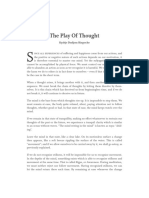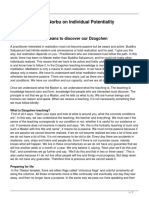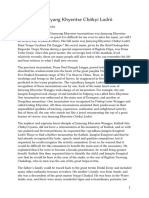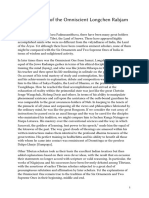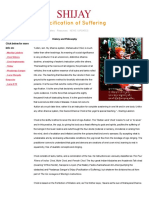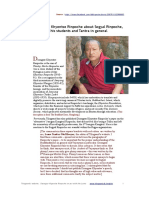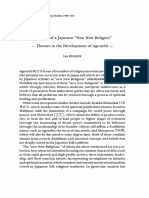Trungpa's Comments On Ngondro, Interview in Torch of Certainty
Trungpa's Comments On Ngondro, Interview in Torch of Certainty
Uploaded by
lawapa8228Copyright:
Available Formats
Trungpa's Comments On Ngondro, Interview in Torch of Certainty
Trungpa's Comments On Ngondro, Interview in Torch of Certainty
Uploaded by
lawapa8228Original Title
Copyright
Available Formats
Share this document
Did you find this document useful?
Is this content inappropriate?
Copyright:
Available Formats
Trungpa's Comments On Ngondro, Interview in Torch of Certainty
Trungpa's Comments On Ngondro, Interview in Torch of Certainty
Uploaded by
lawapa8228Copyright:
Available Formats
TRUNGPA, RINPOCHE: Every type of spiritual discipline, craft or educational system has its beginning, middle and concluding
levels. The Four Foundations (sngon-'gro, literally "prelude") are the beginning of the Vajrayana discipline. Of course, the Vajrayana is not the first but the third level of Buddhist practice, to be preceded by the Hinayana and Mahayana. But those who begin the Vajrayana discipline do so with the Four Foundations. According to tradition, the Foundation practices require a lot of preparation. In the early days in Tibet, people had to have a great deal of training before practicing the: Foundations. This included basic training in tranquility and insight meditation as well as some training in the Mahayana, which included formally receiving the Bodhisattva vow, and so on. The Four Special Foundations are an evolutionary process in which each event has a definite place. They could be connected with the Four Dharmas of Gampopa. In Taking Refuge, your mind begins to follow the Dharma, which is the First Dharma of Gampopa. Your attitude toward yourself and toward everything in your life becomes connected purely with Dharma practice. There is no longer such a thing as a division between sacred and profane. To begin to practice, you must first "give in'' to the Dharma completely. This is accomplished by doing prostrations, a process of complete surrender, of definite commitment. I don't think anyone can begin Vajrayana practice without that. When you take the Bodhisattva vow, having decided to go and havmg bought your ticket, you actually begin the journey-bodhi(itta and the Bodhisattva path. This is related to the Second Dharma of Gampopa, which is that your Dharma practice can actually win success on the path. When you do the Vajrasattva practice, having already surrendered, you have to purify and further acknowledge what you have surrendered. All the impurities must be purified. After purification, something still remains-the pure person, which might contain some stain of arrogance, some stain of existence. In the Mandala practice you actually give everything, including the pure person. You offer this-the giver-as well as all the offerings, at which point, in a sense, you no longer exist. By the time you reach the Guru-Yoga practice, you are psychologically ready to identify with your guru, and immense devotion is born in your mind. This is connected with the Third Dharma of Gampopa, which is that, in following the path, confusion could be clarified. The actual transformation of confusion into wisdom, the Fourth Dharma of Gampopa, is receiving abhishekas and practicing various sadhanas. This is the main part of the Vajrayana discipline, which comes much later. An important difference is that Western students need a lot more prior training in the Hinayana and Mahayana so that they will know what they are doing when they practice the Foundations. Since they lack the cultural background of Tibetans, when introduced to the Foundations they will not be ready to jump into the practices immediately, and they may see them as alien, as some sort of a gimmick. We cannot respond to their doubts by telling them to shut up and have faith. To help them
overcome these doubts, we must train them in tranquility and insight meditation much more thoroughly than was done in Tibet. Apart from these, I don't see any particular differences. Any type of person can do these practices. As long as an individual has become involved in tranquility and insight meditation, his personality has begun to dissolve somewhat. By the time he gets involved in the Vajrayana through the Foundations, he is no longer a "type of person," particularly-he is already there! There should always be the Developing Stage and the Fulfillment Stage together, visualization and formless meditation together. Without that, somehow the whole thing is like fingerpainting rather than actually doing it. There are different levels of formless, of course. Students usually begin by borrowing the Hinayana practice of tranquility and insight meditation, and then out of that some glimpse of the Mahamudra experience might occur. That seems to be very important. The idea is not to trust purely in the gadgets of the practices alone, but that there is something happening behind that. Some kind of unseen, unformed-1 don't know what you'd call it. The incomprehensible is comprehended, with just a few glimpses. That has to happen. Traditionally that is done, and I did that myself. Losing interest in the practice is a symptom of not having enough training in tranquility and insight meditation. Training in tranquility and insight makes you, first of all, very aware of your pain and your neuroses. It increases your mindfulness and enables you to begin to make friends with yourself. You learn how to be by yourself, with yourself. Without this training, you might easily become overwhelmed and .put off by the physical exertion and mechanical aspect of these practices. If a person finds himself put off and feels that he cannot continue the Foundations, he should return to tranquility and insight meditation and go back to the Vajrayana discipline later on. If an individual's practice is not working, this is because he approaches it as some kind of gymnastics, due to a lack of genuine renunciation. He is still blinded by the confused world. In order to begin to see clearly, the practitioner should return to tranquility and insight meditation. This advice is not in conflict with that of the other Rinpoches. The "four thoughts" are a contemplative discipline by which you develop disgust with samsara. If you practice tranquility and insight as the basis of the whole spirirual journey, then the "four thoughts" will arise as a natural process.
You might also like
- Music of Wicker Man With Lyrics To The SongsDocument10 pagesMusic of Wicker Man With Lyrics To The Songslawapa8228No ratings yet
- Taking Emotions As The Path - Tsoknyi RinpocheDocument5 pagesTaking Emotions As The Path - Tsoknyi Rinpochedrimed100% (1)
- Lotsawa House - Longchenpa - The PractitionerDocument3 pagesLotsawa House - Longchenpa - The Practitionerhou1212!No ratings yet
- Commentary On Peaceful ManjushriDocument17 pagesCommentary On Peaceful ManjushriAnonymous IH8qCiNo ratings yet
- A Guide To The Bodhisattvas Way of LifeDocument126 pagesA Guide To The Bodhisattvas Way of LifeFrancesco PassalacquaNo ratings yet
- Dudjom Rinpoche The Play of ThoughtDocument2 pagesDudjom Rinpoche The Play of ThoughtLama GyurmeNo ratings yet
- Shenpen Osel - Issue 11Document88 pagesShenpen Osel - Issue 11Robb RiddelNo ratings yet
- Theravada BuddhismDocument22 pagesTheravada BuddhismPen Tura100% (4)
- James - L. - Papandrea - Reading The Early Church Fathers, From The Didache To NicaeaDocument193 pagesJames - L. - Papandrea - Reading The Early Church Fathers, From The Didache To NicaeaJhon Wilmar MARMOLEJO TRIVINO100% (5)
- Miracle Evangelism - God's Plan To Reach The WorldDocument116 pagesMiracle Evangelism - God's Plan To Reach The WorldDr. A.L. and Joyce GillNo ratings yet
- Viewing the Guru Through the Lens of the Seven Limb PujaFrom EverandViewing the Guru Through the Lens of the Seven Limb PujaRating: 1 out of 5 stars1/5 (1)
- Chogyal Namkhai Norbu Individual PotentialityDocument7 pagesChogyal Namkhai Norbu Individual PotentialitymarcinNo ratings yet
- This Insight Without Objects... LongchenpaDocument1 pageThis Insight Without Objects... LongchenpadalotusNo ratings yet
- Guhyagarbha Series Info For Order FormDocument1 pageGuhyagarbha Series Info For Order FormVivianNo ratings yet
- Commentary On Parting From The Four AttachmentsDocument18 pagesCommentary On Parting From The Four AttachmentsAlenka JovanovskiNo ratings yet
- Blessing Pills BenefitsDocument1 pageBlessing Pills BenefitsDerekNo ratings yet
- Embracing Emotions As The PathDocument8 pagesEmbracing Emotions As The PathJSALAMONENo ratings yet
- NGÖNDRODocument2 pagesNGÖNDROStéphane SmetsNo ratings yet
- Guru Rinpoceh Seven Line Prayer - Front and Back MASTERDocument1 pageGuru Rinpoceh Seven Line Prayer - Front and Back MASTERRon Franklin100% (1)
- WBC 2016 Lojong Retreat SB v5BDocument175 pagesWBC 2016 Lojong Retreat SB v5Bmanoj kumar100% (1)
- Amitayur Dhyana Sutra OnlyDocument27 pagesAmitayur Dhyana Sutra OnlyrohankmitNo ratings yet
- Dzogchen Dilgo KhyentseDocument2 pagesDzogchen Dilgo KhyentsemknaomiNo ratings yet
- Vajracchedika Sutra (Diamond Sutra)Document25 pagesVajracchedika Sutra (Diamond Sutra)jillo54No ratings yet
- Garchen Rinpoche On Especially Those Enemies Who Hate Me PDFDocument1 pageGarchen Rinpoche On Especially Those Enemies Who Hate Me PDFvitralakNo ratings yet
- Notes From Garland of Views Part 2Document17 pagesNotes From Garland of Views Part 2dimeotanNo ratings yet
- Excerpts From Teaching by Lingtrul RinpocheDocument24 pagesExcerpts From Teaching by Lingtrul RinpocheMary Pat Smeltzer Thompson100% (1)
- Healthy Mind Interviews, Volume IVDocument271 pagesHealthy Mind Interviews, Volume IVHenry M. Vyner, M.D.No ratings yet
- Vajrasattva MantraDocument13 pagesVajrasattva MantraBrian JonesNo ratings yet
- James Low Ngondro2 of 5Document50 pagesJames Low Ngondro2 of 5david smithNo ratings yet
- 37 Stages of InstructionDocument2 pages37 Stages of InstructionJosh CarswellNo ratings yet
- Gelong RinpocheDocument6 pagesGelong RinpocheDenis HengNo ratings yet
- Four VisionsDocument3 pagesFour VisionsArya V. VajraNo ratings yet
- Visualization Seattle 1993Document3 pagesVisualization Seattle 1993Logan TrutheNo ratings yet
- The Life of Jamyang Khyentse Chökyi LodröDocument18 pagesThe Life of Jamyang Khyentse Chökyi LodröAndriy Voronov100% (1)
- The Mirror 117Document28 pagesThe Mirror 117emofreeNo ratings yet
- Advice On Yidam PracticeDocument2 pagesAdvice On Yidam PracticehvhhNo ratings yet
- Ciaspolate Valseriana ValgoglioDocument25 pagesCiaspolate Valseriana ValgoglioAndreasJauchMeyrinchNo ratings yet
- Dudjom RinpocheDocument1 pageDudjom RinpocheUmberto AntonelloNo ratings yet
- Tilopa Mahamudra EngDocument3 pagesTilopa Mahamudra EngnekecejNo ratings yet
- Mandala Offering VajrayanaDocument1 pageMandala Offering VajrayanaMarco CennamoNo ratings yet
- Tsa Lung 5: Downward-Moving Wind Practice InstructionsDocument4 pagesTsa Lung 5: Downward-Moving Wind Practice InstructionsHelio JinkeNo ratings yet
- Jamgon Kongtrul The Great: A Short BiographyDocument4 pagesJamgon Kongtrul The Great: A Short BiographyalbertmelondiNo ratings yet
- Issue 4Document64 pagesIssue 4rhvenkatNo ratings yet
- In Praise of LongchenpaDocument3 pagesIn Praise of LongchenpaJigdrel77No ratings yet
- Ganga-Mahamudra-Upadesa of Sri TilopaDocument3 pagesGanga-Mahamudra-Upadesa of Sri Tilopacloclo24No ratings yet
- Shamatha Diagram PDFDocument3 pagesShamatha Diagram PDFtnphubk07No ratings yet
- Biography of Dzongsar Khyentse RinpocheDocument2 pagesBiography of Dzongsar Khyentse RinpocheShenphen Ozer100% (1)
- Ngondro: The Four Extraordinary Foundational Practices.Document1 pageNgondro: The Four Extraordinary Foundational Practices.Justin von Bujdoss0% (1)
- BodhisDeedsComm GJTegchok Nalanda1993-EdSept05Document463 pagesBodhisDeedsComm GJTegchok Nalanda1993-EdSept05Lars SchievingNo ratings yet
- Roaming Yogi - What Is Chod (Shijay)Document2 pagesRoaming Yogi - What Is Chod (Shijay)YDYD1234100% (1)
- HE Irror: Schedule Chögyal Namkhai Norbu 2006Document20 pagesHE Irror: Schedule Chögyal Namkhai Norbu 2006sherabdorjeNo ratings yet
- Longchenpa The Great Chariot Commentary CH 6 7Document100 pagesLongchenpa The Great Chariot Commentary CH 6 7Delos11No ratings yet
- Dzongsar Khyentse On Sex With The Lama Updated July 2018Document25 pagesDzongsar Khyentse On Sex With The Lama Updated July 2018Lungtok Tenzin100% (3)
- The Lion's Roar of a Yogi-Poet: The Great Song of Jetsun Dragpa GyaltsenFrom EverandThe Lion's Roar of a Yogi-Poet: The Great Song of Jetsun Dragpa GyaltsenNo ratings yet
- As Aspirações Do MahamudraDocument64 pagesAs Aspirações Do MahamudratserNo ratings yet
- Heart Advice From Changchub DorjeDocument5 pagesHeart Advice From Changchub Dorjemmnxc15874 mafxx15874No ratings yet
- Introduction To BodhicaryavataraDocument10 pagesIntroduction To BodhicaryavataraguscribedNo ratings yet
- The King of Prayers: A Commentary on The Noble King of Prayers of Excellent ConductFrom EverandThe King of Prayers: A Commentary on The Noble King of Prayers of Excellent ConductNo ratings yet
- (Lama Jang Bod) Calling Lama From A Far by Jamgon Lodro ThayeDocument24 pages(Lama Jang Bod) Calling Lama From A Far by Jamgon Lodro ThayeSpringlocNo ratings yet
- Kyabje Dudjom Rinpoche On Negative Effects of Tobacco (Tibetan Text)Document2 pagesKyabje Dudjom Rinpoche On Negative Effects of Tobacco (Tibetan Text)lawapa8228100% (1)
- A Prayer To Recognize My FaultsDocument8 pagesA Prayer To Recognize My FaultsAnonymous IH8qCiNo ratings yet
- Rebkong NgakpasDocument11 pagesRebkong Ngakpaslawapa8228100% (1)
- Arshad Ul QadriDocument3 pagesArshad Ul QadriAbdulRazzaqQadriNo ratings yet
- Iconography and Retrospect OfSri Jagannath PRABHUDocument5 pagesIconography and Retrospect OfSri Jagannath PRABHUnsprasad88No ratings yet
- World Religion and Belief System (Summary)Document34 pagesWorld Religion and Belief System (Summary)rosalie moneraNo ratings yet
- Baby Names Inspired by Lord Shiva and Their Meanings 3Document7 pagesBaby Names Inspired by Lord Shiva and Their Meanings 3pankaj kararNo ratings yet
- 1 Peter - One of My Favorite Books of The New TestamentDocument1 page1 Peter - One of My Favorite Books of The New Testamentkcmarshall99No ratings yet
- Five Dhyani BuddhasDocument3 pagesFive Dhyani BuddhasnieotyagiNo ratings yet
- LAL, Buddhism's Disappearance From IndiaDocument4 pagesLAL, Buddhism's Disappearance From IndiaMarco PassavantiNo ratings yet
- Jeopardy Game - CATECHISMDocument54 pagesJeopardy Game - CATECHISMDReyes100% (1)
- An Islamic Discussion On MagicDocument6 pagesAn Islamic Discussion On MagicDr.Touhid Muhammed Faisal kamalNo ratings yet
- Koinonia in The New TestamentDocument8 pagesKoinonia in The New Testamentcreyente_madrileño100% (1)
- Growing Deeply - Week of August 10Document1 pageGrowing Deeply - Week of August 10Missouri United Methodist ChurchNo ratings yet
- By Cecilio Duka From Notes We HandleDocument2 pagesBy Cecilio Duka From Notes We HandleSheryl Suñas SarzaNo ratings yet
- A Brief Biography of Hazrat Maqdum Fakhi Ali Al-MahaimiDocument13 pagesA Brief Biography of Hazrat Maqdum Fakhi Ali Al-MahaimiMohammed Abdul Hafeez, B.Com., Hyderabad, IndiaNo ratings yet
- Prayer Power: Interceding For OthersDocument9 pagesPrayer Power: Interceding For OtherselahviktoriaNo ratings yet
- Pratyabhijna Hridayam - Ram Shaiva Trika AshramDocument154 pagesPratyabhijna Hridayam - Ram Shaiva Trika Ashramishwarashram100% (4)
- Sakti Shrines and Kapalika PracticesDocument2 pagesSakti Shrines and Kapalika PracticesadyakaliNo ratings yet
- Analogy of BeingDocument14 pagesAnalogy of BeinghenriqueNo ratings yet
- Gnosticism (The Christian Institute)Document6 pagesGnosticism (The Christian Institute)spaghettipaulNo ratings yet
- Excuse of IgnoranceDocument11 pagesExcuse of IgnoranceSheikhSulaymanNo ratings yet
- Using The Omamori GohonzonDocument1 pageUsing The Omamori GohonzonSmiti SaxenaNo ratings yet
- AgonshuDocument27 pagesAgonshuAzulina KickyNo ratings yet
- Praying For Spiritual LeadersDocument4 pagesPraying For Spiritual LeadersServant Of TruthNo ratings yet
- Dasa Maha Vidya SthothrasDocument7 pagesDasa Maha Vidya SthothrasNarayanan Muthuswamy100% (1)
- Importance of Islamic EducationDocument2 pagesImportance of Islamic EducationSaifullah Bismillah100% (1)
- People Become Like Their GodDocument3 pagesPeople Become Like Their GodJurgenSchulzNo ratings yet
- Nabi Muhammad SAW Dalam Kitab HinduDocument8 pagesNabi Muhammad SAW Dalam Kitab HinduTkko riasto100% (1)
- What Is SpiritualityDocument1 pageWhat Is SpiritualitySantoshNo ratings yet







